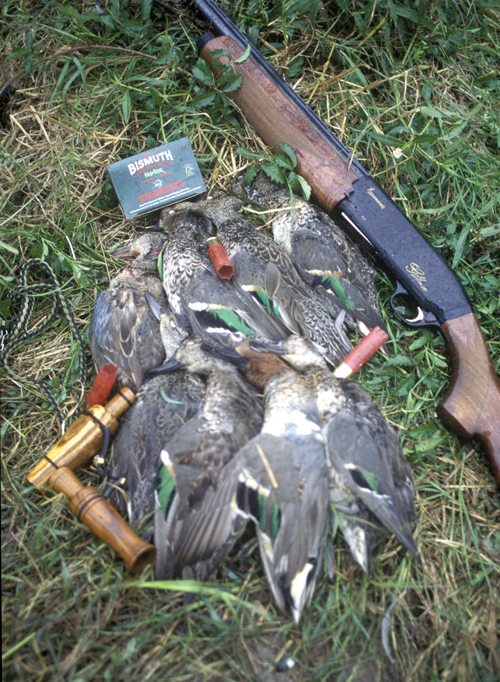
EARLY TEAL SEASON IS IN FULL SWING until Sept. 30. The limit is six teal a day. Pictured above are birds bagged by two hunters, but each hunter must carry the birds he shot. Number six shot size is recommended. Photo © John Jefferson.
by John Jefferson
It usually rains enough right before dove season to fill ponds and puddles and scatter the doves. Occasionally, a hurricane in the Gulf comes ashore and inundates part of the state, ruining dove hunting as it did in coastal areas last year. But, this year, the opening day of dove season was dry. And hot. Then, it started raining and fields got sloshy. Our lease agreement says we are not to drive on the farm if it’s muddy. We’re into our 15th consecutive day of rain as I write this. That all-time record of 40 DAYS is getting closer.
Ted Clark, former TPWD dove project leader, often said that “…doves don’t like to get their feet muddy.” Ever see a flock of doves sitting on a power line after a rain? That may be why. They’re ground feeders, and either aren’t comfortable trudging around in a muddy field or their feathers got wet and they want to dry them for quick getaways from predators before they venture off the safety of the wires. Whatever the reason, it’s been raining all month, so far, leading up to the opening of the regular season in the South Dove Zone on September 14. That probably disappointed hunters in those areas as much as it did shooters in the North and Central zones shortly after those areas opened. Much of the state has gotten rain, except the Panhandle.
But as dove season enters its third week, the wet conditions favor those intrepid souls that hunt teal. Early teal season opened September 15 and closes September 30, as does the Eastern Zone Canada goose season.
Hunting waterfowl takes a certain amount of “want-to”, but harsh conditions don’t bother the dedicated. The “glass-half-full” guy observing a cold rain falling one winter day who termed it “A good day for ducks” must have been a duck hunter. Hunting teal in September at least doesn’t involve near freezing weather. It does, however, entail other issues like hot weather, mosquitoes, and water moccasins. Be prepared and dress appropriately.
Teal are fast. Good hunters must be quick, too, but must be safe. Know where your hunting mates are well before you shoot. Blue-winged teal are usually the first waterfowl to arrive, but if you see a flight of smallish birds rapidly coming at you as if late to dinner, shoot ‘em. All teal are legal in September. Kevin Kraai, TPWD’s waterfowl leader, says shallow water with seedy vegetation is ideal for teal. Dark decoys and an experienced teal-caller will help. One year, we set up on our deer lease lake over deep water and wondered why we didn’t have any teal when daylight came. Now we know.
For all migratory waterfowl, you’ll need a Texas hunting license with a migratory game bird endorsement, an H.I.P. certification, a Federal duck stamp, a hunter education certificate if age-required, a shotgun plugged to hold no more than three shells unless it’s a double barreled piece, and non-toxic shells. A camouflaged face also helps.
JJ




